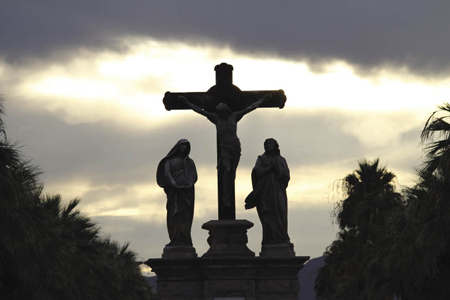Faith Column: God doesn’t have a penis
Scripture needs gender-neutral language
James Wilt
Faith Columnist
If you want a guaranteed method to piss off a conservative Christian, bring up The Shack in conversation.
The New York Times best-selling fiction book, which was released in 2007, drew a flurry of criticism for so-called inaccurate theology. The biggest travesty of all was that God was portrayed as a woman.
William P. Young, the author, probably didn’t mean to expose the sexist views of traditional Christianity, but he did a mighty fine job, nonetheless.
The most shocking response came from Mary Kassian, a member of the Council on Biblical Manhood and Womanhood (the name alone is suggestive of their emphasis on gender roles.)
Kassian, who’s also a women’s studies professor at the Southern Baptist Theological Seminary (the same school that introduced a homemaking course for women only), wrote: “God has chosen to reveal himself with male imagery. Father is HE. Son is HE. Holy Spirit is HE. That’s not to say that God is male. He encompasses everything that is good about masculinity and femininity. But that doesn’t mean that we have the liberty to think or refer to him as female. That’s crossing a line we have no right to cross.”
Aside from contradicting herself (God is a HE, but not necessarily), Kassian — who graduated from the University of Alberta — proved conservative Christianity still can’t wrap its sexist head around the notion that God isn’t a man despite the fact that the feminine nature of God is present throughout the Bible. Also, the assumption that God has a penis and chest hair ignores the reality that the Bible was written in a male-dominated culture, mostly by men.
In Genesis, Moses wrote that “God created man in his own image, in the image of God he created him; male and female he created them” (1:27). In Deuteronomy God was recorded as saying, “You deserted the Rock, who fathered you; you forgot the God who gave you birth” (32:18). The feminine imagery of God was carried over in the New Testament when Christ used the metaphor being “born again” (John 3:5). Unless God’s a seahorse, he actually has to be a she too.
The fact that the femininity of God isn’t recognized by groups like the Southern Baptist Convention matters. As the late Mary Daly, a pioneering feminist theologian, once said, “When God is man, man is God.” More specifically, when God is only referred to as king, lord, and father, the value of women is diminished, and the religious laws prohibiting women from leading congregations, and sometimes speaking in church, are cemented.
Ida Raming, another feminist theologian, has pointed out that this sexist and demeaning behavior means “women are, in practice, being denied their resemblance to God.” How is that not a bad thing?
If men and women are created in the image of God, then conservative Christianity is missing out on hearing half of what God has to say by continuing to use masculine pronouns to describe God and refusing to let women speak in its congregations.
The United Church is making headway by starting the Lord’s Prayer with “Our Mother and Father in heaven.” The International Bible Society recently released an obviously controversial edition of the NIV with gender-neutral language.
It’s time for all subscribers to Christianity — or any religion or spirituality — to get on board with these fascinating examples and continue to challenge the notion that God is a man. The patriarchal illusion is hurting everybody.






I agree about changing gender roles and stereotypes within Christianity, but I still would find it hard to say “Our Mother and Father in Heaven.” Maybe I’d just have to get used to it? Plus it sounds like you’re praying to two entities.
I think if I can say one word, “God,” and recognize that I’m referring to a triune entity, I can also say “Father” and recognize that I’m referring to an entity that is without gender. But not all people recognize that, so I guess adjusting the wording would help…
Good article, though, as usual.